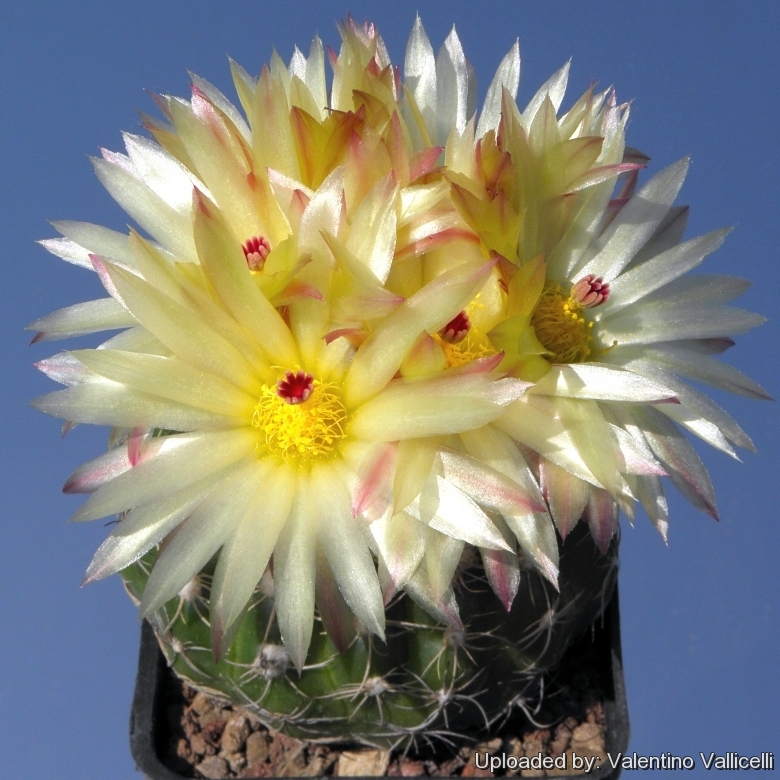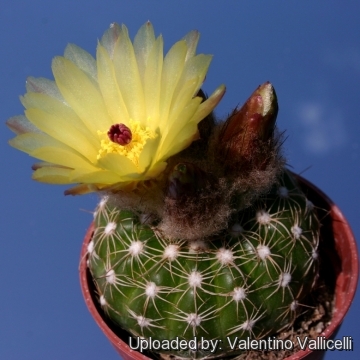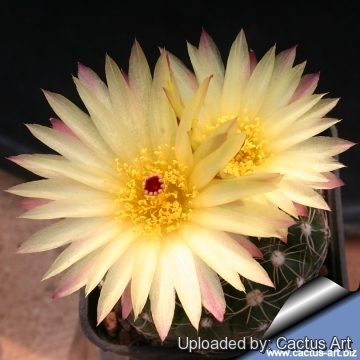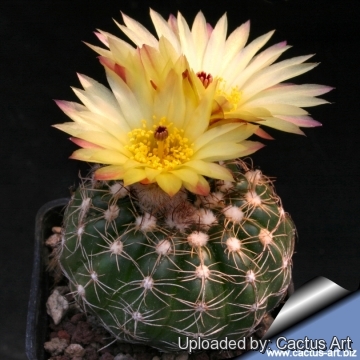Accepted Scientific Name: Parodia concinna (Monv.) N.P.Taylor
Bradleya 5: 93 (1987)

Notocactus apricus var. concinnus (Parodia concinna) Photo by: Valentino Vallicelli
Origin and Habitat: Parodia concinnaSN|3536]]SN|3536]] is distributed in Southern Brazil (Rio Grande do Sul) and in practically all of Uruguay.
Altitude range: elevations from 20 to 300 metres above sea level.
Habitat and Ecology: The species grows on rocky outcrops in grasslands or pampas. A generation length of 10 years has been inferred based on field observations.
The species is relatively common but not abundant. The populations are decreasing, and a 50% decline over 30 years (including past and future) is estimated for Brazil based on direct observation, and if considering the whole range the decline is probably around 30%. The major threats are cattle grazing, illegal collection and forestry of Eucalyptus.
Synonyms:
See all synonyms of Parodia concinna
back
Accepted name in llifle Database:Parodia concinna (Monv.) N.P.TaylorBradleya 5: 93 (1987)Synonymy: 50
back
Common Names include:
ENGLISH: Sun Cup
Description: Parodia concinnaSN|3536]]SN|3536]] is small cactus species forming a flattened and much-ribbed sphere.
Stem: Simple, broadly globular or somewhat depressed at apex, eventually longer in age, about 3-10 cm tall, and 4-10 cm across, light or dark glossy green, ribbed and warty at the top.
Ribs: About 16 to 20, with somewhat conspicuous chin-like tubercles between the areoles
Areoles: Young areoles white-felted.
Spines: Spreading, setaceous, hair-like to bristle-like, some more or less curved to twisted, brown, reddish or partly whitish to yellowish often poorly differentiated as centrals and radials.
Radial spines:9 to 25, about 5 to 7 mm long adpressed and interlaced.
Central spines: 1-4(-6), one much longer (1-2,5cm ), spreading or turned downward.
Flowers: 1-5 produced together at the apex, bright yellow, funnel-shaped, large, about 5 to 8 cm across. Outer perianth-segments narrow, acute, reddish, inner perianth-segments oblong, yellow almost transparent, except the reddish tips, acute. Stigma-lobes scarlet. Scales on the ovary hairy in their axils. Perianth-tube slender.
Blooming season: Summer.
Fruit: Green ovoid to globular approx. 1,5 cm cm long, thin-walled, splitting or disintegrating at maturity with more than 100 seeds per fruit.
Seed: 0,8-1 mm, bell-shaped broadest at the hilum, somewhat, tuberculate, shiny and black.
Subspecies, varieties, forms and cultivars of plants belonging to the Parodia concinna group
 Notocactus agnetae var. aureispinus Vliet: like subsp. agetae but with thin yellowish spines.. Distribution: Uruguay (Rocha, Lavalleja and Maldonado).
Notocactus agnetae var. aureispinus Vliet: like subsp. agetae but with thin yellowish spines.. Distribution: Uruguay (Rocha, Lavalleja and Maldonado). Notocactus concinnus var. apricus (Arechav.) P.V.Heath: has stems spherical 3-4 cm wide, apex umbilicate covered with interlocking brownish-reddish spines. Distribution: surroundings of Maldonado, Uruguay.
Notocactus concinnus var. apricus (Arechav.) P.V.Heath: has stems spherical 3-4 cm wide, apex umbilicate covered with interlocking brownish-reddish spines. Distribution: surroundings of Maldonado, Uruguay.- Notocactus concinnus f. joadii (Arechav.) Havlíček
 Notocactus concinnus var. yerbalitoensis W.Prauser: has about 20 ribs. Distribution: Yerbalito, Cerro Largo, Uruguay.
Notocactus concinnus var. yerbalitoensis W.Prauser: has about 20 ribs. Distribution: Yerbalito, Cerro Largo, Uruguay. Parodia concinna (Monv.) N.P.Taylor: has 16-20 tubercled ribs, 9-25 bristle-like radial spines and 1-4(-6), one much longer (1-2,5cm ), spreading or turned downward centrals. Distribution: Southern Brazil, Uruguay.
Parodia concinna (Monv.) N.P.Taylor: has 16-20 tubercled ribs, 9-25 bristle-like radial spines and 1-4(-6), one much longer (1-2,5cm ), spreading or turned downward centrals. Distribution: Southern Brazil, Uruguay. Parodia concinna subs. agnetae (Vliet) Hofacker: has dense thin brownish spines and more closely set areoles. Distribution: Uruguay (Rocha, Lavalleja and Maldonado).
Parodia concinna subs. agnetae (Vliet) Hofacker: has dense thin brownish spines and more closely set areoles. Distribution: Uruguay (Rocha, Lavalleja and Maldonado).- Parodia concinna subs. blaauwiana (Vliet) Hofacker
Bibliography: Major references and further lectures
1) Edward Anderson “The Cactus family” Timber Press, Incorporated, 2001
2) James Cullen, Sabina G. Knees, H. Suzanne Cubey "The European Garden Flora Flowering Plants: A Manual for the Identification of Plants Cultivated in Europe, Both Out-of-Doors and Under Glass" Cambridge University Press, 11/Aug/2011
3) David R Hunt; Nigel P Taylor; Graham Charles; International Cactaceae Systematics Group. "The New Cactus Lexicon" dh books, 2006
4) Franz Buxbaum “Morphology of cacti”, Volume 1 Abbey Garden Press, 1950
5) Nathaniel Lord Britton, Joseph Nelson Rose “Cactaceae: Descriptions and Illustrations of Plants of the Cactus Family” Courier Dover Publications, 196
6) Peter McHoy “The New Houseplant A-Z: Everything You Need to Know to Identify, Choose, and Care for the 350 Most Popular Houseplants” Smithmark Publishers, Incorporated, 01/Mar/1996
7) Krainz, Hans (Hrsg.) “Die Kakteen” 1957-1975 Franckh'sche Verlagshandlung
8) Hiroshi Hirao “Colour encyclopaedia of cacti” Seibundo Shinkosha, 1979
9) Hans Hecht “BLV-Handbuch der Kakteen” BLV-Verlagsgesellschaft, 1982
10) Kristo Pienaar “The South African what Flower is That?” Struik, 2000
11) John Borg “Cacti: a gardener's handbook for their identification and cultivation” Blandford P., 1970
12) Tony Mace “Notocactus: a review of the genus incorporating Brasilicactus, Eriocactus and Wigginsia” Editorial Board/National Cactus & Succulent Society, 1975
13) Larocca, J., Machado, M. & Duarte, W. 2013. Parodia concinna. The IUCN Red List of Threatened Species 2013: e.T151724A554335. http://dx.doi.org/10.2305/IUCN.UK.2013-1.RLTS.T151724A554335.en. Downloaded on 20 October 2016.
 Notocactus apricus var. concinnus (Parodia concinna) Photo by: Valentino Vallicelli
Notocactus apricus var. concinnus (Parodia concinna) Photo by: Valentino Vallicelli Notocactus apricus var. concinnus (Parodia concinna) Photo by: Cactus Art
Notocactus apricus var. concinnus (Parodia concinna) Photo by: Cactus Art Notocactus apricus var. concinnus (Parodia concinna) Photo by: Cactus Art
Notocactus apricus var. concinnus (Parodia concinna) Photo by: Cactus ArtSend a photo of this plant.The gallery now contains thousands of pictures, however it is possible to do even more. We are, of course, seeking photos of species not yet shown in the gallery but not only that, we are also looking for better pictures than those already present.
Read More... Cultivation and Propagation: It is relatively easy to grow on its own roots.
Soil: Grow it in an open sandy-gritty cactus compost.
Pots: It needs a relatively shallow pot to accommodate its fibrous roots and provide a very good drainage. It may stay in the same pot for many years.
Watering: Water in moderation, it prefer a completely dry place during winter. Mature individuals easily rot and die especially after planting so be extremely cautious with watering. Keep dry in winter or when night temperatures remain below 10° C. Water it less than average if in bigger pots.
Special need: Provide very good ventilation. Nearly all problems occur as a result of overwatering and poor ventilation, especially when weather conditions are dull and cool or very humid.
Fertilization: Feed them once during the growing season with a fertilizer specifically formulated for cactus and succulents (high potash fertilizer with a dilute low nitrogen), including all micro nutrients and trace elements diluted to ½ the strength recommended on the label. They thrive in poor soils and need a limited supplies of fertilizer to avoid the plants developing excess vegetation, which is easily attacked by fungal diseases.
Exposure: It will do its best with lots of sun and become stressed with inadequate light which could result in poor growth and unnatural shape.
Hardiness: It likes warmth (recommended minimum winter temperature 5° C) however plants kept perfectly dry can can survive low temperatures, approx. -5°, but for safe cultivation it is best to avoid freezing temperatures.
Use: This is a good pot plant suited for a non heated green house. It can be also cultivated outdoors in raised beds, terraces if sheltered from winter rain. This cactus continues to be, a particular prize among collectors
Pests & diseases: These cacti may be attractive to a variety of insects, but plants in good condition should be nearly pest-free, particularly if they are grown in a mineral potting-mix, with good exposure and ventilation. Nonetheless, there are several pests to watch for:
- Red spiders: Red spiders may be effectively rubbed up by misting the plants from above.
- Mealy bugs: Mealy bugs occasionally they develop aerial into the new leaves and flowers with disfiguring results, but the worst types develop underground on the roots and are invisible except by their effects.
- Rot: Rot is only a minor problem if the plants are watered and “aired” correctly. If they are not, fungicides won't help all that much.
Propagation: Seeds. The seeds can be sown in pots of fine, well-drained sandy soil, any time during the spring when temperatures are warm. Cover the seeds with a fine layer of grit and water from below with a fungicide to prevent damping off. For the 1-2 weeks cover the pots with a sheet of glass/clear perspex to keep the humidity levels high. Remove the glass and replace it with light shade-cloth and mist once or twice a day for the next two weeks after which most seeds should have germinated. From then on mistings can be reduced to every second and then every third day as the little plants grow.














